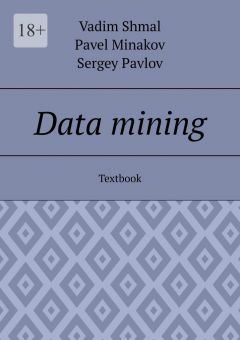Текст книги "Data mining. Textbook"

Автор книги: Vadim Shmal
Жанр: Математика, Наука и Образование
Возрастные ограничения: +18
сообщить о неприемлемом содержимом
Текущая страница: 2 (всего у книги 6 страниц) [доступный отрывок для чтения: 2 страниц]
Classification
Classification is the task of generalizing a known structure to be applied to new data. For example, an email program might try to classify an email as «legitimate», or «spam», or maybe «deleted by the administrator», and if it does this correctly, it can mark the email as relevant to the user.
However, for servers, the classification is more complex because storage and transmission are far away from users. When servers consume huge amounts of data, the problem is different. The job of the server is to create a store and pass that store around so that servers can access it. Thus, servers can often avoid disclosing particularly sensitive data if they can understand the meaning of the data as it arrives, unlike the vast pools of data often used for email. The problem of classification is different and needs to be approached differently, and current classification systems for servers do not provide an intuitive mechanism for users to have confidence that servers are classifying their data correctly.
This simple algorithm is useful for classifying data in databases containing millions or billions of records. The algorithm works well, provided that all relationships in the data are sufficiently different from each other and that the data is relatively small in both columns and rows. This makes data classification useful in systems with relatively little memory and little computation, and therefore the classification of large datasets remains a major unsolved problem.
The simplest classification algorithm for classifying data is the total correlation method, also known as the correlation method. In full correlation, you have two sets of data and you are comparing data from one set to data from another set. This is easy to do for individual pieces of data. The next step is to calculate the correlation between the two datasets. This correlation of two sets of data tells you what percentage of the data is in each set. Thus, using this correlation, you can classify data as either one set or the other, indicating the parts of the data set that come from one set or the other.
This simple method often works well for data stored in simple databases with a small amount of data and slow data access speeds. For example, a database system may use a tree structure to store data, with the columns of a record representing fields in the structure. This structure did not allow data to be ranked because the data would be in two separate rows of the tree structure. This makes it impossible to make sense of the data if the data fits in only one tree structure. If the database has two data trees, you will need to compare each of the two trees. If there were a large number of trees, the comparison could be computationally expensive.
Therefore, full correlation is a poor classification method. Data correlation does not distinguish between relevant parts of the data, and the data is relatively small in both columns and rows. These problems make full correlation unsuitable for simple data classification systems and data storage systems. However, if the data is relatively large, full correlation can be applied. This example is useful for storage systems with a relatively high computational load.
Combining a data classification method with a data storage system improves both performance and usability. In particular, the size of the resulting classification algorithm is largely independent of the size of the data store. The detailed classification algorithm does not require a lot of memory to store data at all. It is often small enough to be buffered, and many organizations store their classification systems this way. Also, the performance characteristics of the storage system do not depend on the classifier. The storage system can handle data with a high degree of variability.
Why are classification systems not so good?
Most storage systems do not have a good classifier, and the data classification system is unlikely to get better over time. If your storage system does not have a good classifier, your classification system will have problems.
Most companies don’t think this way about their storage systems. Instead, they assume that the system can be fixed. They see it as something that can be improved over time based on future maintenance efforts. This belief also makes it easy to fix some of the problems that come from bad storage systems. For example, a storage system that doesn’t accept overly short or jumbled data can be improved over time if more people are involved in fixing it.
Summing
Summing – providing a more compact view of a data set, including visualization of the data structure, is useful for solving simpler problems and searching for data for statistical patterns and inferences. You can often approximate this structure by modeling the structure with an algorithm similar to linear modeling.
After the central limit theorem, these results are often more useful for theoretical purposes. One of the main differences is that linear models are not very robust to displacements, and a linear model often does not provide a powerful, natural modeling method. The rectilinear model has one correlation term (which may be linear) and is insensitive to correlations between many parameters. The result of linear modeling is often that many factors contribute to one result. This is often good because we can easily distinguish between different phenomena by separating them, but it is less useful for analyzing problems in which multiple variables are correlated, such as product prices or survey measurement.
There are many other alternatives to linear modeling that are not as resistant to biases. For example, cubic statistics is often a simple way to model correlations in linear models and provides several useful shortcuts for analyzing the performance of many parameters. The power matrix is a related technique that is often used in computational biology to model biological systems. Linear modeling requires complex mathematics to derive it, so there are often other ways to model the underlying processes, even in these areas.
Unfortunately, the linear model is an excellent tool for performing simple regression analysis in situations such as comparing the prices of individual items in a dataset or analyzing a single result because it gives reasonable results with low statistical error. Some datasets also include relatively simple linear models. Because the linear model can be extended, many applications of computational methods are often based on linear models.
Datasets that require more sophisticated modeling to characterize are usually more useful for theoretical purposes. Examples of this are modeling population structures by modeling the interaction of several variables, or modeling financial transactions in the financial market using a more complex way of modeling the interaction between several variables, such as limited regression.
Many fields of computing and statistics use «linear programming» to determine the solution to complex problems involving many variables.
Linear model parameters
The datasets use various parameters for the linear model in the form of linear regression parameters, linear model variables, and auxiliary parameters. Similarly, parameters are used to specify variables in a linear model. These parameters can be omitted, but they can be useful for modeling most problems.
Typically, a number of parameters are specified, and then a linear model variable is specified for each of those parameters. The number of parameters is usually a good way to describe how many groups the data includes.
The parameters are usually modeled as a set of linear algebraic equations of the form (this equation is an equation with a constant coefficient for each parameter). Different parameters are often modeled with different equations, as required by the data structure. If there are multiple independent variables and one independent variable for each parameter, then one set of independent variables is often modeled with linear equations for each parameter. The equations can vary for each parameter to help model the data.
The output of a linear model is a set of constant factor coefficients based on the variables and each of the parameters. Constants can be linear or linear combinations of parameters. Linear coefficient matrices are often not suitable because they are useful for analyzing data in a linear way, and a linear model is often not suitable. Another good modeling option is to use an extension of the linear model called a multilevel linear model.
Linear models can often have an additional parameter based on an auxiliary variable. The auxiliary parameter can be modeled as a linear model matrix, but can also be modeled as a linear model matrix with several assumptions.
Many linear models require multiple linear regression parameters to model a complex problem. Since the problem uses several independent variables, the linear model is useless in most situations. Often this happens because a simple linear model is not enough to describe a complex process.
An alternative is to create a linear model, but then use an appropriate auxiliary parameter to set the initial parameter values. This will allow the linear model to be used in many situations.
Variable settings
As noted above, variables are usually set for each model parameter. Each parameter setting has a set of effects based on the variable and parameters. If the initial values of the parameters are given using linear equations, then the linear equation will describe a set of variables. The linear equation usually includes some parameters that are not in the data set to model those parameters.
Variable settings can often vary depending on how the dataset is presented.
Parameters can also be used as an example. Each parameter can be thought of as an independent variable, and each independent variable is often thought of as a value that will determine the parameter. Typically, the function of each parameter is defined as a dependent variable that will determine the value of the parameter. If the parameters include dependent variables, then the functions defined for the parameters are usually functions with a constant coefficient. The parameters are a set of linear equations for the dependent variable and are often referred to as the independent variables.
You can set the parameter settings based on your data. Typically, if you have data for two independent variables, the parameters are set to include the dependent variables to determine the parameters. This will create a linear model using only two independent variables. Using parameters to set dependent variables will also have other implications for the linear model. For example, if the values of the dependent variables are slightly different, then the parameter settings may not be completely linear.
If your model uses dependent variables and the dataset is different, you may need to adjust the dataset before using options to set options. This may mean adding or removing some dependent variables. Because the dependent variables are sometimes missing from the dataset, you may need to place other constraints on the parameters. The details of setting parameters to include dependent variables will vary depending on the types of parameters used in the model.
The parameter set usually includes a linear model by default. You can usually set the options to include other models or include a different set of options. This option will also create a more complex model. In many cases, it is desirable to include all parameters in the model, including those that are not in the dataset. This can often result in a much simpler model than a model that only includes dataset parameters.
In some situations, it is necessary to perform mathematical modeling of the problem to see if a solution can be found. Models often use similar variables and parameters. Simulation results can also be applied to many different situations. For example, if you know how datasets will be represented on a computational graph, you can use mathematical modeling techniques to find a good representation for the data to make the model more valid.
For example, you might have a function that shows how many variations there will be in a stimulus. You can evaluate different views of the data to determine which one works best for your data. As a rule, if there are not many possible models, then it is more likely that the selected representation is the correct one. The function will change depending on the data. If the data is presented as images, it will be adjusted to include the most common forms. The model will adjust based on the number of images included in the dataset. As the number of images in the dataset increases, the model will adjust. This means that you are generally more likely to choose the right model when the data is not represented as a set of image features.
Graph-based datasets can help you specify the model that is used to represent the data. This is usually a representation of graph theory. There are multiple views for each set of options. Different datasets have different graph theories, so you can choose the graph theory that best fits the data for your dataset.
Data personalization in forecasting
Data mining can be inadvertently misused and can lead to results that appear significant; but which do not actually predict future behavior and cannot be reproduced on a new data sample and are of little use in practice.
Over the past few decades, there has been a great deal of academic and corporate interest in what we call personalization. Personalization refers to the improvement of individual services or other offerings to users by recognizing the specific tastes of individual users and displaying those preferences in new and desirable ways. One data point is of no value, as there is a problem in identifying the corresponding individual data points. So, the data has to be verified by biometrics, personality tests, questionnaires, and perhaps even psychological tests.
The ultimate goal of personalization is to create services that deliver greater value to end users. If this becomes possible, it will also be possible to create new services that create new profit opportunities for enterprises and their shareholders.
Huge variability in personal preferences has supported the production of personalization-driven services for some time. However, the potential inherent in personalization does not automatically mean that every business can benefit from personalization. Enterprises with data-driven operations face two questions: first, what can be measured in the current environment; and second, can the current environment be improved by such measurements and rethinking of past behavior?
Both of these questions are difficult to answer when the data is generated from legacy forms of personalization. On the one hand, even though many consumers and companies seem to agree that their personalization is beneficial, there remains uncertainty about what constitutes personal preference and what is simply the result of positive self-reinforcing friends and colleagues. For many businesses, advertising with general purpose demographics alone is not enough, and they can make big profits by improving self-enhancement through such means and incorporating such personalization into various services.
On the other hand, some data is now being collected that goes far beyond personalization. If more companies start collecting all the data of their customers, then all transactions can be subjected to social profiling. If this is not directly aimed at individuals, then the processing of data may be indirectly related to individual preferences. Some of this data is related to self-assessment of consumption, and some of it is important for other purposes. In addition, there are a number of current and proposed services that require the collection and subsequent analysis of data. For many businesses and industries, data is a staple; without data, they have no way to predict patterns that will eventually lead to profitable business opportunities.
The greatest advantage of data from a business perspective is that it is able to deliver all of a company’s products and services in the most predictable way. Therefore, it can be sold to each end user in the most predictable way, all based on personalization. But more importantly, as the data is explored and presented to individual users, it becomes possible to create new services that can actually predict individual users’ consumption patterns. And once the data is actually analyzed and statistically compared with previous patterns, it becomes possible to generate a new prediction of that person’s behavior in the future.
How can such forecasts be made? Consider the difference between traditional personalization and personalization with data. In traditional personalization, the service provider creates a product or service tailored to personal preferences. A product is exactly the type of product or service that the customer needs. In a personalization-focused service, it is possible to change or adjust a product to match the consumption patterns of other people with similar or identical consumption patterns. Predicting consumption patterns can generate new services.
The question then becomes, how does the difference between personalization with data and personalization with personal preferences affect the role of data in a business enterprise? Does predicting consumption patterns really need to be accompanied by the collection of personal data? That is, would it be better to create a new product or service that works this way instead of focusing on personal preferences with data?
Both types of personalization can increase the chances of creating successful products and services. Personalization with data reduces the risks to the system, both in terms of ongoing service and in terms of the system failing over and over again. It is much easier to correct a negative forecast with data than it is to correct a positive forecast by recalculating the consumption pattern of past customers or entities. For example, if a consumption model with data predicts that customers in a restaurant generally like their food, and a consumption model with personal preferences predicts that they do not necessarily like the food, then the consumption model with personal preferences would need to be adjusted through deeper analysis to predict the consumption model with personal preferences. how this pattern changes over time and can be predicted. It is in this context that instead of overcompensating negative prediction of personal consumption patterns, successful products and services can indeed be created.
To give an example of what is possible, let’s look at the general idea of selling personal items online. There are products and services that include items that the consumer is willing to buy or consume. There are also products that include only the product that the consumer is willing to buy or consume. In this sense, the service provider has created a package that will help preserve the market by offering not what the consumer does not want to buy or consume, but only to use specific products. By incorporating personal preferences into packaging, it is possible to predict what a consumer will or will not buy. For example, similar to data-driven personalization, personalization based on personal preferences would involve examining what consumers are willing to purchase with data and combining the data with their own personal preferences. The prediction of what purchases consumers will make on any given day will be based on a combination of data with personal preferences.
In this case, the consumer is ready to buy the product on the day he has chosen, but may not want to buy it on another day. By comparing purchase patterns and personal consumption patterns of past consumers and individuals, a company can look at the overall trend in consumption patterns and assume that a consumer might buy a product. By taking these people and making a prediction based on personal preferences and combining it with past customer models, the company can see if they are likely to buy a product on a given day. This strategy can be very effective in certain situations. Personal preference for a particular product or service can provide important information for identifying trends in the purchasing behavior of future consumers.
To make a forecast for a purchase model, a company will need to make a forecast for a consumption model, which must have a personal preference at the end of the forecast. For this particular prediction, the recommendation of which products or services to recommend will be based on personal preference or personal data. To make such a prediction, a company needs to have a personal preference for a particular product or service. If the prediction is correct, then the consumer will be willing to buy the product or consume that particular product or service. The consumer may not buy the product at a certain time, but at least he will buy it sooner. In this case, the prediction would be successful and there would be no need to further investigate why the consumer would buy the product earlier, because that particular decision is justified based on personal preference.
It should be noted that personal preference is not always sufficient for an accurate prediction. A personal preference may be a service that is very similar to what the consumer is willing to buy on the current day. If they are willing to purchase a service from the same provider on the same day, the service provider will not be able to predict when that consumer will purchase the service based on personal preferences. In this case, they would have to look at the buying patterns for each individual consumer and think that the consumer might buy the service sometime during the next week or month. Otherwise, the service provider can only predict that the consumer has a chance to buy the service sometime during the next week or month. This strategy will require a more comprehensive approach to assessing current and past consumer buying patterns in order to make predictions for future consumers. If a consumer is willing to buy the same product or service every day, the supplier will only be able to predict the consumer’s future purchase, but will not know the probability that that consumer will buy the product at any time in the coming weeks, months, or years. This is a personal preference of that particular customer and may provide useful information to the supplier. But personal preference will not provide good predictive value.
Artificial intelligence experts believe that personal preferences can be a good tool to determine how consumers are willing to consume products and services in the future. By studying current and past consumer and personal consumption patterns of past consumers, suppliers can predict which products and services future consumers will prefer. This would be especially useful in a wide range of industries such as the service industry. In retail, service providers could study the buying behavior of current consumers and anticipate future consumers’ personal preferences for future products and services.
Some attempts have been made to define standards for the data mining process. However, the end result of these standards is often the continued definition of the target. Each group will then attempt to create an index that the end user can read by mapping each data point to the type of object it represents, resulting in hash tables. We won’t get data from this process until the system is optimized and the index is big enough to represent any object in some way. We will probably come up with an ideal solution in the end user world, and it will be much easier to search for objects in large databases than to manually change the index for objects in the database. But in a production system, we don’t need perfect solutions. We need optimal solutions. This will require understanding not only the types of objects, but also their meaning. When it comes time to add data to the system, all that remains is to add the object to those modules that are involved in the process. As long as these modules are treated with the same expectations, the end user should be able to change the process much more easily than if we tried to define a separate language for each module we want to share. And since there will most likely be a module for each data object, the end user will be able to define processes that run only on those data objects. The end user will never lose the knowledge of which data object they are using and can always request that the module be replaced with a different data object. They can also request data from a module and define a particular kind of operation on that data, and the module can serve as a control mechanism to perform these functions.
However, building systems that work for our end users will require a few more changes. First, if we want our systems to be easy to modify, we will inevitably get a new product every time a new set of data comes out. It is best if these systems are self-contained so that they can be changed as long as the desired properties are present. It is also likely that some type of artificial intelligence will be involved in these systems to determine the desired properties and build the system in such a way that it performs the correct operations for this set of data. We can simplify this process by defining the data properties that apply to each operation and creating that particular operation for the data. Allowing the computer to examine the data and decide what changes to the data to make is useful not only for new datasets but also in development situations. If we need data structures that can serve data for any period of time, it is important that we define those structures and then write applications that operate on the data at that time. Therefore, when we create a new data structure for a particular set of data, it is useful to define the specific language we use to describe the information contained in that structure. These languages allow us to define our tools in a way that is easy to reuse across multiple datasets. Because they are defined using domain-specific languages, we don’t have to worry about whether it is possible to find the definition of a particular structure for a particular set of data, or whether there are a million ways to write the same definition, because the computer will automatically figure out what a structure means. desired properties. If the computer cannot build the structure, then the process is probably too complex for the end user to understand.
A lot of this process happens automatically, and a lot depends on the assumptions about the data structures. But building systems that work for our end users is not possible unless we start learning about the data structures that make up our systems. When the first software systems became available, their developers were forced to create an entirely new language and entirely new programming methods to deal with the kinds of data they were developing. The fact that many of the new data structures ended up being written in simpler languages than the original developers were accustomed to was a symptom of the abandonment of the more pragmatic approach to system development that we build today. We have the ability to build systems that work for our end users, and it’s important that we pay attention to the data structures that make up our systems.
Внимание! Это не конец книги.
Если начало книги вам понравилось, то полную версию можно приобрести у нашего партнёра - распространителя легального контента. Поддержите автора!Правообладателям!
Данное произведение размещено по согласованию с ООО "ЛитРес" (20% исходного текста). Если размещение книги нарушает чьи-либо права, то сообщите об этом.Читателям!
Оплатили, но не знаете что делать дальше?








































